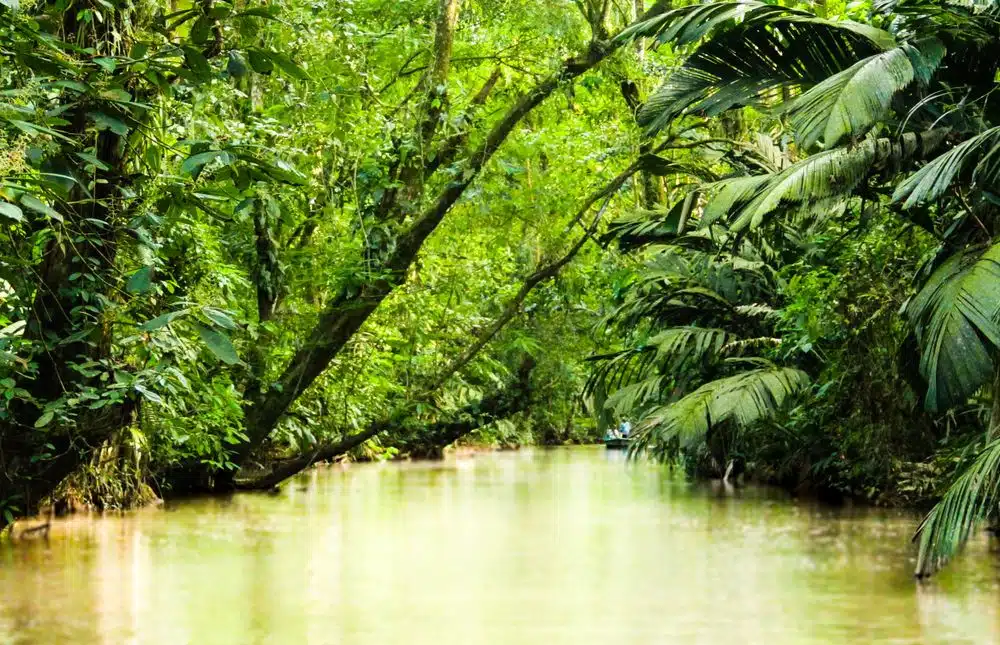Nicolas Dubreuil spends time with the people of the river
In order to both offer its passengers novel and unique ports of call and evaluate and limit the environmental and societal impact of disembarking in threatened areas of the world, PONANT has developed a scouting and exploratory programme named Ponant Discovery. After an initial scouting mission to the Bissagos Islands, the trimaran Titaina Explorer set sail for Guyana in December 2019. Nicolas Dubreuil, sustainable development director and expert in polar and tropical expeditions at PONANT, tells us about his experience at the heart of the Guyanese jungle.
The River People
Nicolas Dubreuil : “And we’re off – I have finally found Olivier and Yannick on the Titaina Explorer in Saint-Laurent-du-Maroni in French Guiana. It’s another mission for us: to explore the possibilities of the River Maroni. No cruise boat has ever got up this far, as the Maroni is very shallow.
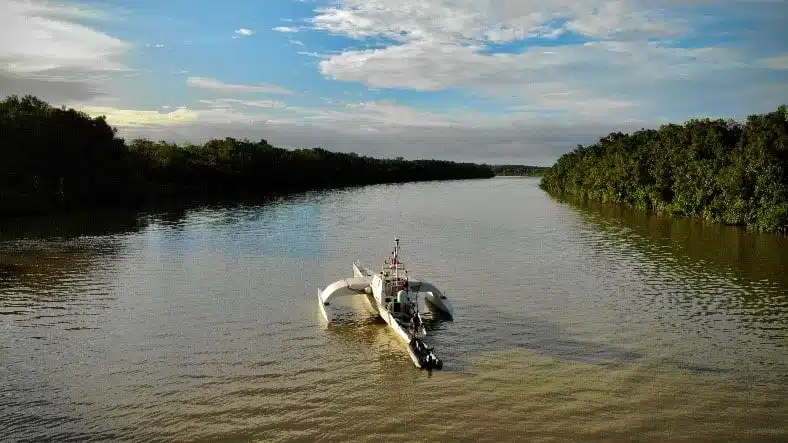
On my arrival a succession of meetings is set up. The first thing to do is to fully understand where the Maroni dredging project is at and what the implications are for us and the surrounding ecosystem.”
Navigating the Maroni
“Saint-Laurent-du-Maroni is a town that appears to be visibly expanding. There are many reasons, but it depends in part on rampant Suriname immigration. The Saint-Laurent-du-Maroni maternity hospital can no longer meet demand. The country’s second largest town is pretty isolated. The distance of 200km that separates it from the capital is only passable by a small B-road or by air. Given the situation, maritime transport would be a much quicker and more ecological way to supply all of western Guiana. So the Guianese government has decided to dredge the Maroni at three key least shallow points.
We have arrived at the right time to express our interest and discuss technical problems. At the moment, depending on the tide, our ships could reach Saint-Laurent-du-Maroni about 30% of the year. We propose they dredge down to a 5.5m depth to achieve 90% navigability. This solution is in line with government expectations and seems to suit everyone.
During the meeting I discover that sand from the Maroni river bed will be chucked into the sea to be dispersed by the ocean. But I also know that the entrance to the Fjord, the long Awala beach and main nesting site for leatherback turtles, is under relentless attack by the river. It is gouging out the right bank, cruelly cutting into Awala beach which is considerably reducing the area for nests. Some blame the river’s action on gold panning, others on climate change … but in reality no-one knows the cause. So I am proposing an environmental impact study to determine the reasons behind this phenomenon, which is increasing every year, to see if the sand extracted during dredging would replenish this beach and in fact conserve this leatherback turtle habitat. Something to follow up with the PONANT Foundation…
The meeting with tourism operator reps from Saint-Laurent-du-Maroni was fascinating. The tourism practiced here is very familial, adventure-orientated and in the majority of cases eco-responsible. From a tourism point of view however, French Guiana has a particularly bad image. All we hear about this country, especially this western region, are problems related to the Surinamese, drugs trafficking, gold panning and a particularly aggressive ecosystem (snakes, spiders, etc. ). All that does exist, but on a much smaller scale. French Guiana has an exceptionally rich biodiversity and is much less dangerous than one imagines. Once again, our mission is to take guests from the virtual to the real by immersing them in nature’s wildernesses.“
French Guiana, a history shaped by a penal colony
“A not so shining aspect of French history, but very present in Guiana that cannot be ignored is the penal colony – Le Bagne. A story as tragic as it is fascinating! Who can remain indifferent after visiting the Transportation Camp in Saint-Laurent-du- Maroni? Rising to great heights like the walls of a prison is the Guianese forest. Three crimes in a row in France and it was straight to the penitentiary. How moving then to come across cell 47 with the name engraved on the ground: PAPILLON! A name that immediately conjures up a thousand adventure stories. It was during this visit and from a story by a former convict that I discover the existence of many other camps. Some were well hidden, mainly the toughest ones where they sent the most difficult convicts. Camps in the middle of the jungle, in the middle of the swamps… It was the prison administration itself that decided to close down these camps as being far too dangerous. And what if we were to discover one? If we came across the ruins of one of these totally unknown camps in the heart of the Guianese forest? I have to investigate!“
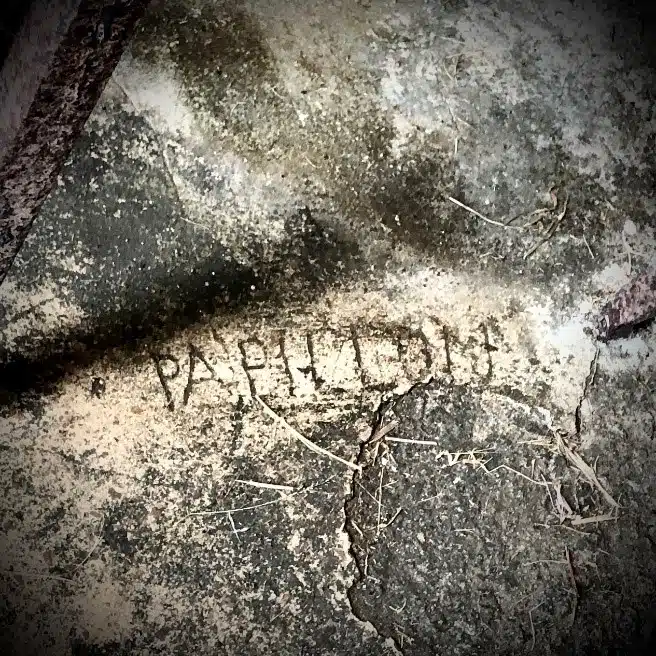
French Guiana, symbol of biodiversity
“But before we leave: we need supplies! A visit to the Saint-Laurent-du-Maroni market is a must. Such a colourful market. I only know half of the food produce on display. Redcurrants? But they look nothing like redcurrants? Fruits of many colours light up the market. What strikes you most, and reflects to perfection the diversity of flora, is the diversity of people. I spent an hour roaming round this market and heard thousands of languages! I crossed paths with a thousand ethnicities! What a boon, as a result of the collateral damage of a penal colony. In addition to his sentence a convict had to stay at least the equivalent period in Guiana, which served to cut them off completely from the western world and encouraged them to settle here, thus increasing the river’s diversity.
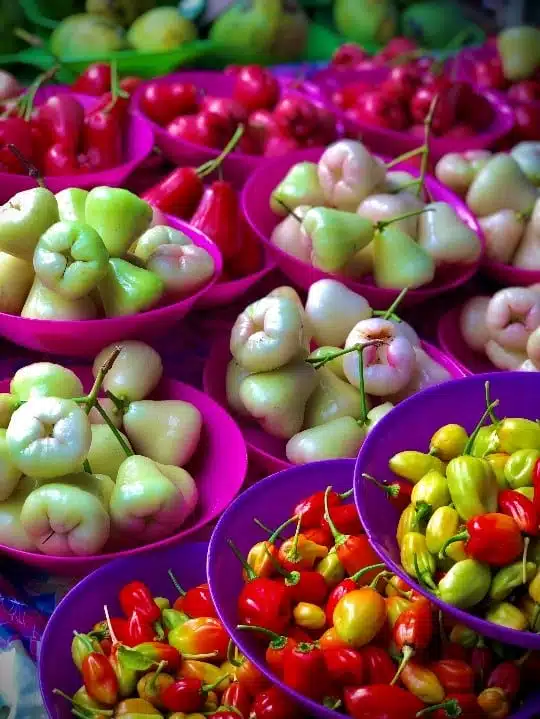
The visit to the market makes me realise that the western world is trying to apply a rule that doesn’t work here. We can’t use the river as a border! This dotted line on maps which cuts the River Maroni in two, separating France and Suriname is sacrilege. Here the river is a unifying element. It brings together all these people who merrily go from one bank to the other. Kalin’a, Bouchiningué, Negmarron, Surinamese, Amerindians, etc. all are one and the same – the River people! Amidst this incessant to-ing and fro-ing of dugout canoes, French gendarmes try their best to enforce an impossible modern law. We must adapt to the obvious.
Tomorrow morning we are leaving early to explore all the River Maroni’s navigable inlets. Hundreds of kilometres to travel, in a Zodiac at the foot of the jungle, to discover the flora and fauna, the culture and history. There is no tourist offer, we have to create it! We’re going to follow in the footsteps of Papillon when he escaped… I dream of new discoveries!”
Guianese forest and network of inlets
“We go down the Maroni by making every depth measurement possible and imaginable. It’s an impressive trip: the channel obliges us to pass very close to the forest, just ten metres away! We feel like we can almost touch the trees. The birds seem ready to land on the deck. I imagine the view we would have from one of the Explorers: from a stateroom with no horizon except the forest or from the top deck looking over the canopy! Here the forest is a vegetal extension of the sea, it blends in completely with the water. It all merges together, there is no real border.
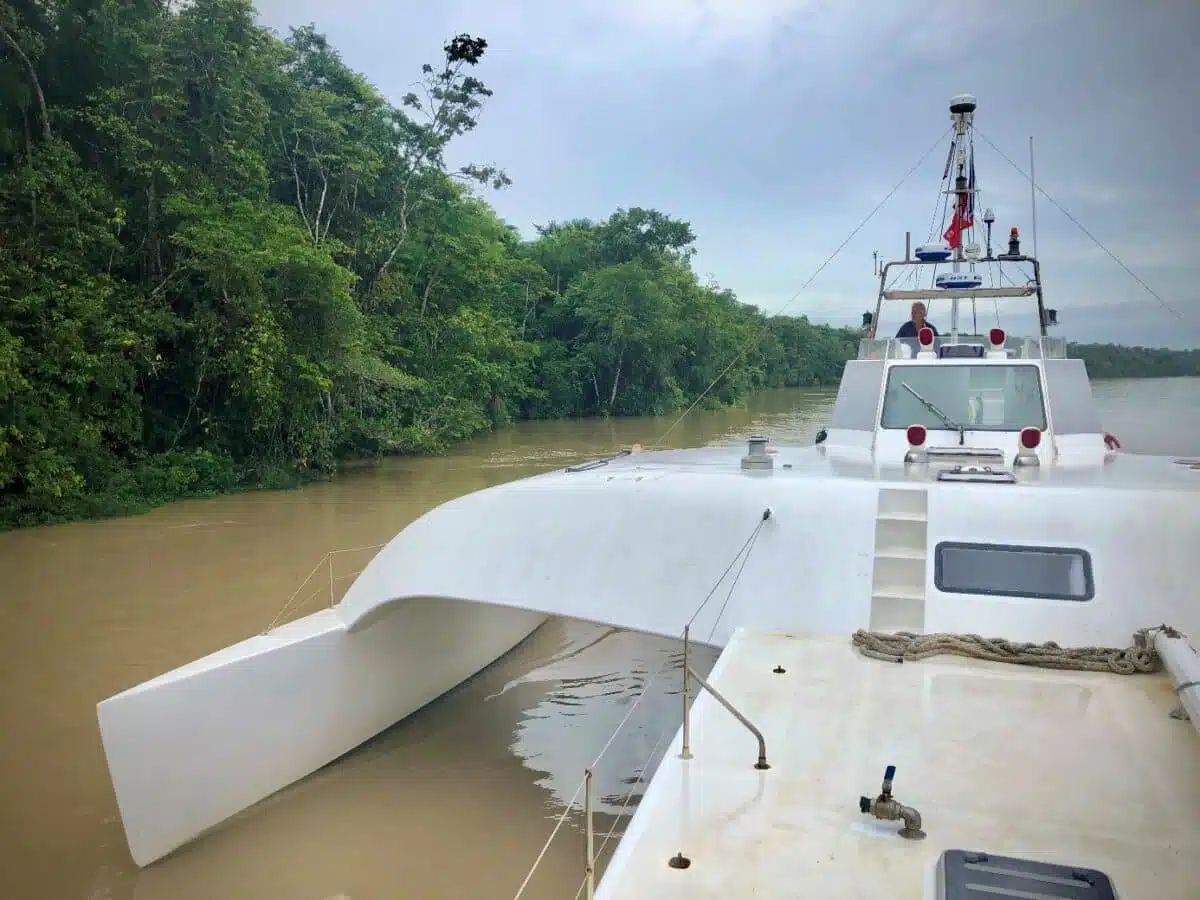
We go back to the landing buoy to carry out our surveys. For some passages we have less than two metres of water under the keel, and yet we are several miles from the river’s exit in the middle of the sea!
Back on the Maroni after the morning surveys, we penetrate deeper into the forest by venturing up an inlet as far as our draught will allow us. Then we’re off! We lower the Zodiac to embark on an adventure. December is the worst season as it rains a lot . And in Guiana “a lot” doesn’t have the same meaning as it does in France. We are regularly battered by torrential rain. But the water isn’t cold and it’s so hot. Another advantage of the rain is that suddenly there are fewer mosquitos. Nothing really protects you against the rain. You just have to suffer in silence and adapt.
Where we are in the forest is sublime. Very diverse, a mixture of mangroves and forest, inlets that get narrower and narrower, the sights and sounds amazing. It is difficult to imagine surviving in this particularly hostile environment. How did Papillon, that famous convict, manage to survive and cross this region without losing his way? We are navigating through a labyrinth of inlets. Without a map or GPS we would very quickly be lost. When the heavens open, it’s like a grey curtain that completely blocks the view. Magnificent and mysterious!
We explore every branch of the river meticulously. Sometimes we are blocked by trees or it’s just the end of an inlet; other times we suddenly pop out into another branch.
At a bend in one inlet, I get out to assess how far we have progressed into the forest; a forest which gives the impression that we are being watched. How many eyes are fixed on me when I manage to cross a muddy mangrove swamp to reach firm ground on the bank? Places are teaming with life! I advance slowly with a machete, taking care not to lift leaves of trees from underneath as that’s where spiders shelter from the pouring rain. My GPS no longer works in the forest, the tree cover is too dense. So I mark my path by breaking branches at different heights to signal changes of direction. It’s only been ten minutes since I left, yet Olivier who is waiting for me in the Zodiac already can’t hear me anymore. Progress is slow, the terrain is stable and interesting. A few spiders, a snake, bird calls. The heat is intense. I advance. I’m looking for the best way. I would like to come across another branch of the river or better still discover some remains –for I’m not at this particular spot by chance – I have done some research in order to find – perhaps – the location of the famous convict’s camp. But still nothing. And then, I’m blocked by an impenetrable mangrove. Carefully I retrace my steps. It’s not easy finding your way back in this jungle.
I try another place, but similar – even muddier! Not easy! My information is not accurate enough. Tomorrow, I must meet a Shaman Kalin’a… I will talk to him about it and perhaps he’ll have some ideas.
Our return journey to the Titaina is more eventful than expected… A hole in the hose and we cannot restart the Zodiac. While Olivier finds a makeshift solution to this failure, I keep paddling so the river doesn’t take us into the middle of the mangrove or into dangerous areas. Unfortunately, it’s a rising tide which pushes us inland; luckily it’s not raining … Oh no! I spoke too soon! Stair-rods fall just as the engine roars into life. We all burst out laughing! We will reach the Titaina as night falls. A night that will be spent at anchor in the middle of the inlet, between the howler monkeys and parrots – a waking dream!”
Tchalimina, The one who knows
“It is important to describe this vital step when doing a recce, and that is finding good contacts! We need to identify the right spokespeople, those with whom we can build a shared vision of the project and commit to a partnership for the long-term.
It often follows a similar pattern. Among the dozens of people we meet, or are advised to meet, we must sort through them and not make a mistake when choosing the right profile depending on our aims. My goal: that our guests enjoy an authentic experience in the jungle, that they meet the child who still lies dormant within them, the child who dreamed of isolated clans and gold rushes.
I am looking for someone I trust, an expert in the terrain, a local, and above all someone who wants to share. My choice is naturally directed towards an Amerindian, preferably a hunter, a chieftain rather than an elder, but someone who is proud of their country.
I have been given a contact. I only have a description of him but one small detail pleases me: he is not interested in meeting at Saint-Laurent-du Maroni. On the other hand he has let me know that he is building a canoe in a small village at the river mouth, and if I ever want to come and see it… That’s it! The die is cast! We’ll have to coax him. In this type of relationship, money and promises count for nothing, only the genuine item. These people can read us like an open book. Sincerity is key. I call him. He’s called Gaëtan (a true Breton name!!). He sets a date to meet on a beach. The Titaina arrives early – it’s important never to be late for a meeting. The weather is awful but at least it’s not raining. I look out for him through my binoculars. I see him at the end of the beach. His silhouette and easy stance in this tropical region leave me in no doubt – he is definitely an Amerindian. An Amerindian called Gaëtan. I jump in the Zodiac, Yannick will drop me at the beach. But I already know my disadvantage: I am too tall compared to him.
I arrive at the beach, I jump out of the Zodiac. This is an important moment, the first encounter. This is when it will all come down to whether this is a case of liking or animosity. He looks at me and doesn’t say much. I walk on the lower part of the beach to try and appear shorter. I ask him some questions. He responds vaguely. He is testing me through my questions: they are not good ones. I am finding it difficult to concentrate as I am being eaten alive by mosquitoes, this being the rainy season. He walks slowly. I don’t want to produce the mosquito repellent and appear weak. But then the heavens open – Eureka, saved by the rain!
That’s when he decides to talk to me – for a long time without moving. There’s a little shelter but a lake of water suddenly tips out over my head. I sense that I look ridiculous, my hair plastered down, my shirt stuck to my body. The wind picks up and suddenly I’m freezing. He turns his back to the wind, while the rain lashes my face. And he talks – and talks – and talks – very slowly, searching for the right word, he is still testing me. I don’t flinch: of course I love the rain and the cold. Phew, he suggests we move to a “carbet”, a wooden shelter typical of Amerindian cultures.
The discussion continues. We speak of everything and nothing, I try to learn as much as I can about him. I describe our projects and what we would like to show our guests. I ask if he would agree to accompany me to the numerous coves around his village and if he would like to introduce me to his jungle, his village and family. His answer speaks volumes: “Yes – why not. I have lots of things to do but I can manage it all!” That’s good! It is starting to take shape! We board the Titaina. I explain to my spokesperson that we want to confront guests with nature in the raw, wild and untouched, to encourage them to become ambassadors for his country. And that this is why I would like to offer them a hike in his jungle. He has to take me! I ask him to teach me a few phrases in the Kalina language. He smiles and teaches me the following:
- Toualo atcho: Be careful
- Tilpolote pompa keton: Don’t go there
- Mootake: You’ll hurt yourself
- Soupara a toukou: You don’t know how to use the chopper
The message is clear: he is teasing me! I look at him and say: “I can see you don’t have much confidence in me!” And we both burst out laughing! He looks me in the eye and says: “My Amerindian name is Tchalimina – the one who knows. Welcome to my home!” And that’s it, it’s all systems go!
Tchalimina was born and lives in a very small typical Amerindian village in the Guianese jungle. His knowledge is impressive, he knows every corner of the jungle, every plant, every sound! I taste everything he tells me to taste. I have to show that I trust him so that he will trust me. A leaf, a piece of bark, some sap, a grub – mmm? OK, why not. I think of my daughter when we were both watching The Lion King and of the bit she adores when Simba bites into a caterpillar. I hear her giggling as I bite into this large juicy grub… Tchalimina looks at me: “It’s disgusting isn’t it? Me, I don’t like them at all!” The traitor!
Penal colony and the Amerindians
“It’s impossible not to link French Guiana’s modern history to its penal colony – Le Bagne! Or rather several forced labour camps. The Transportation Camp in Saint-Laurent-du-Maroni is not unique, it is the central camp of the “Maroni agriculture penitentiary colony”. There are therefore outlying isolated colonies that no-one talks about, the traces of which have been lost amidst the vegetation along the 1,500 km² of the Maroni. I even discovered in a book the existence of a camp in the middle of the jungle in the mangroves, a priori not far from where we are now, but did not manage to find the green hell.
Convicts were used to doing all kinds of work. The penal town of Saint-Laurent-du-Maroni was so well maintained that when Albert Londres stayed there he compared it to a little Paris. Even now when you pass through some districts it’s like being propelled back into the heart of a 1930s film.
The first major facility to be built was the telegraph cable connecting Cayenne to Saint-Laurent over a distance of more than 353km, a particularly difficult section being the ascent of the Maroni. Cable maintenance was managed by a supervisor with 15-20 Annamese, Malagasy and coolie convicts who the prison administration believed “were better at resisting malaria, so common in the swampy regions the cable crossed”. In 1910, the telegraphic cable was moved to run along the road to make it easier to manage. The convicts were then sent off to recover sap from the balata gum trees, latex – the Amazon’s new gold. But living conditions were so harsh that in September 1928, prison administrators themselves were highly critical of the way the camps were managed and closed them.
It was then that the Kali’na Amerindians slowly started to reinvest in the area, but not without problems because as a prison guard pointed out this region was “uncontrollable and infested with escaped convicts” – like Papillon. Anyone attempting to escape the Saint-Laurent-du-Maroni colony had no choice but to hide in this mangrove and build a craft solid enough to go to sea. In living memory, some can still remember tragic events and bloodthirsty attacks on Amerindian villages by escaped prisoners who had nothing to lose.
I dream of offering our guests a unique adventure, a truly exceptional discovery far off the beaten track. Something no-one else is doing, to find this camp and confront the reality of it, far from museums and reconstructions.
I return to Tchalimina to tell him I have failed to find this labour camp. Before helping me, he invites me to come and see something very special: a tree, the tree of the Shamans. He has given me a wonderful gift, as it was here that for his Shaman initiation Tchalimina had to submit his body to being bitten by hundreds of Youkouli, particularly aggressive ants, that plunged him into a sort of coma for several days allowing him to interact with the spirits.
Accompanied by his youngest son, we walk through the jungle and I ask him about the large holes in the ground:
– Are there rats here?
– Oh no! that’s a Matoutou.
– Matoutou?
– Yes, like that one! he says, laughing and pointing to the top of my head with his chopper.
I thought I could feel something there, but have been too busy looking at the ground. I run my hand through my hair and find a Matoutou… I leave you to look it up on the internet to see what that is!
Tchalimina walks without stopping. The forest is sublime, it’s everything we dream about when looking at maps of Guiana, relishing in mysterious names like Maripasoula, Awala Yalimapo, Papaichton… Suddenly he stops. My impression is that we have been walking all over the place, but my GPS will show just how accurate Tchalimina has been, thanks to his incredible knowledge, in finding his way through this impenetrable forest.
I’m sitting on a tree trunk, Tchalimina hands me my bag. I feel lost… as if I’ve been in a very deep sleep. Tchalimina laughs loudly and says: “You must learn how to travel without moving. Come on, I’ll show you what you are looking for.”
We set off, and after an hour in this interminable jungle we arrive at a well – a well built with bricks in perfect condition. Each brick is inscribed with the initials AP for “Administration Pénitentiaire”. We’ve found it. This is the famous camp. Completely taken over by the jungle. Incredible… even the foundations of the barracks are visible. I imagine what life was like for these convicts so isolated from the world, where walls and watchtowers are not necessary. I can almost hear their conversations, the guards’ shouting orders between the cries of parrots and howler monkeys. In this forest without borders, without limits, you really appreciate how indomitable nature can be, the only rampart against human folly. This exhausting day ends my quest.
I can’t wait to bring you here.”

